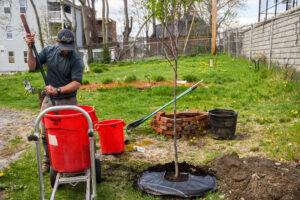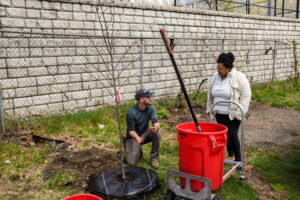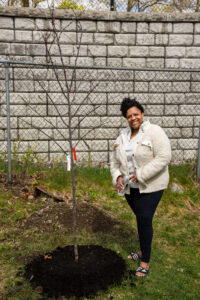By Liz Nye, New England Botanic Garden Staff
May 2023
 “It’s the moment of truth,” Seth Libby says to Jackie Harris as he sets down his shovel and grabs hold of the trunk of a small eastern redbud tree. He turns the tree so Jackie can view it from all angles. “Which side do you like best?” he asks. The tree is destined for a spot behind Jackie’s house, a beautiful old Victorian in Worcester’s Main South neighborhood.
“It’s the moment of truth,” Seth Libby says to Jackie Harris as he sets down his shovel and grabs hold of the trunk of a small eastern redbud tree. He turns the tree so Jackie can view it from all angles. “Which side do you like best?” he asks. The tree is destined for a spot behind Jackie’s house, a beautiful old Victorian in Worcester’s Main South neighborhood.
Jackie purchased her home more than 30 years ago. While her property includes several mature trees, there’s also a lot of development nearby. Parking lots, basketball courts, a medical center. With triple-decker houses, iconic architecture in many Worcester neighborhoods, lining the street in close succession, it’s easy to make a case for more green.
New England Botanic Garden at Tower Hill, where Seth works as horticulture outreach field supervisor, runs a program striving to green Jackie’s neighborhood and others in the city of Worcester one tree at a time. Through the Get a Tree, Plant a Tree program, people interested in hosting more plant life on their property can receive free trees and tree planting services.
The program has been keeping Seth busy this spring. Jackie’s tree is already his third planting of the day—and that’s a good thing. These trees not only enhance the visual and financial value of homes, they also create healthier places to live.
Combatting Urban Heat Island Effect in Worcester
A growing body of research demonstrates that robust tree canopies are essential to the livability of cities. Trees improve air quality, mitigate stormwater, and contribute habitat and food resources for insects and birds in the urban forest. Trees also help to regulate temperatures. Without enough tree shade, urban spaces get hotter and stay hotter than surrounding areas through what’s known as the urban heat island effect. Urban heat islands develop as impervious surfaces like pavement and roofing absorb heat during the day and radiate it back out at night. In 2019, researchers at WPI measured a nearly 17-degree difference in air temperature between areas in Worcester and outside towns.
As climate change brings warmer temperatures and more extreme weather, the dangers of urban heat island effect grow—but they don’t grow equally for everyone. In cities across the U.S., legacies of systemic racism enacted through policies like redlining mean that communities of color and people with low incomes often face higher heat risks associated with too few trees.
Worcester needs more trees. Between 30,000 and 35,000 are needed according to a recent study the city had conducted by Georgia Institute of Technology’s Urban Climate Lab. Why so many? In 2008 an infestation of Asian Longhorned Beetle, a non-native insect, decimated the city’s urban forest. At the time, Worcester’s tree canopy was a near monoculture of maples, a favorite food source for the beetle. Now, in addition to combatting the urban heat island effect and creating equitable access to green space, it’s important that tree planting efforts carried out also diversify the urban forest.
Last month, the City of Worcester released a draft of an Urban Forest Master Plan. The comprehensive plan, developed by ecological solutions firm Davey Resource Group in collaboration with community partners, lays out action items for the next seven years and beyond.
 Building an Equitable and Biodiverse Urban Forest
Building an Equitable and Biodiverse Urban Forest
With a $70,000 grant from the State of Massachusetts’ Greening the Gateway Cities Program (GGCP), New England Botanic Garden expanded its tree planting initiative in environmental justice communities where tree benefits are needed most. This spring and summer, 100 young trees will be planted in Worcester’s Main South, Bell Hill, and Grafton Hill neighborhoods. With hopes for another infusion of state funds later this year, plus additional support from sponsors like Fletcher Tilton Law Firm, the Garden plans to plant even more trees next fall.
Whether facing extreme weather events, pests, or disease, biodiversity is one of the best ways to build resiliency for the future. Part of the Garden’s tree planting strategy, and a requirement under its GGCP funding, is that trees be planted in accordance with the 10-20-30 rule. This guidance suggests that urban forests contain no more than 10% of any one species, 20% of any one genus, or 30% of any family in order to prevent catastrophic tree loss from pests. The Garden plants around 25 different tree species all with attributes from ornamental appeal to pollinator support and more through the Get a Tree, Plant a Tree program. In addition to eastern redbud, the Garden’s tree list includes tupelo, sweet gum, white and scarlet oak, tulip, American hornbeam, hawthorn, and others.
Requesting Trees for Your Home
To receive a tree through the Garden’s Get a Tree, Plant a Tree program, property owners complete a brief request form that is available on the Garden’s website in English and Spanish. Then Garden staff choose a tree for the homeowner that is right for the property. The Garden works with community partners and canvasses Worcester neighborhoods to share information about the program.
Jackie thinks more trees and other community greening efforts like planters on the sidewalks of Main Street are good things for the neighborhood. They make the area look nicer and more friendly. So she spreads the word about the Get a Tree, Plant a Tree program to friends, family, and neighbors. “It was so easy to work with Seth,” she says. “He got right back to me with information and a plan to get my tree here.”
With every tree that goes into the ground through the Get a Tree, Plant a Tree program, the Garden provides support to set up community members for long-term success. This means providing tree care instructions in multiple languages, planting trees with large enough mulch rings to prevent damage from mowers, ensuring trees get enough water during their first two years, and conducting site visits to answer questions and monitor tree health. To help make tree care easy for homeowners, the Garden also installs Tree Diapers made from recycled materials that absorb rainwater and release it slowly to keep the tree hydrated and reduce its need for hand watering. “We really want this program to have a big impact,” Seth says. “And we want people to be able to enjoy their trees and all the different benefits they bring for years to come.”
When it’s time for Jackie’s tree to go into the ground, she picks a “front.” Though with its magenta blooms, the redbud is pretty from all sides. It will grow 12 to 14 feet tall. Jackie looks forward to the wildlife, especially birds, more trees will attract. Bumblebees already buzz around the dandelions blooming throughout her lawn. Come fall, Seth hopes the Garden will be able to add another tree to Jackie’s yard. She has the space, and the neighborhood has the need.
Liz Nye is the Public Relations Manager at New England Botanic Garden. She holds a master’s degree in science writing from Johns Hopkins University and enjoys learning about and writing about all things plants.
